Engines are pretty complicated pieces of machinery, making it no wonder that many people don’t know how they work. As 3D printers have become readily available to the public, they’ve opened the doors for creative minds to turn their ideas into reality, and more people can learn about engines by 3D printing and assembling the components manually.
In this article, we’ll go over our top picks of engines that you can 3D print – even if you may need extra parts to fully set them up – and a few projects that show where the technology may be headed. Since the engines are made out of several 3D printed pieces, you can 3D print each component in a different color. This lets you clearly see, for example, where the valves are and how they move.
While some of these models are even functional (no, you can’t replace the one in your car with it, but you can use it on a toy car), they’re great ways of both learning about engines and testing your printer’s capabilities. If the latter isn’t perfectly tuned or you don’t want to go through the hassle of printing so many parts, consider Craftcloud. With manufacturers all over the world offering a variety of materials and colors, you can have the components delivered to your doorstep so that you can focus on assembly.
But before we check out our picks of the most advanced 3D printed engines, let’s take a closer at what engines are and how they work.
How They Work
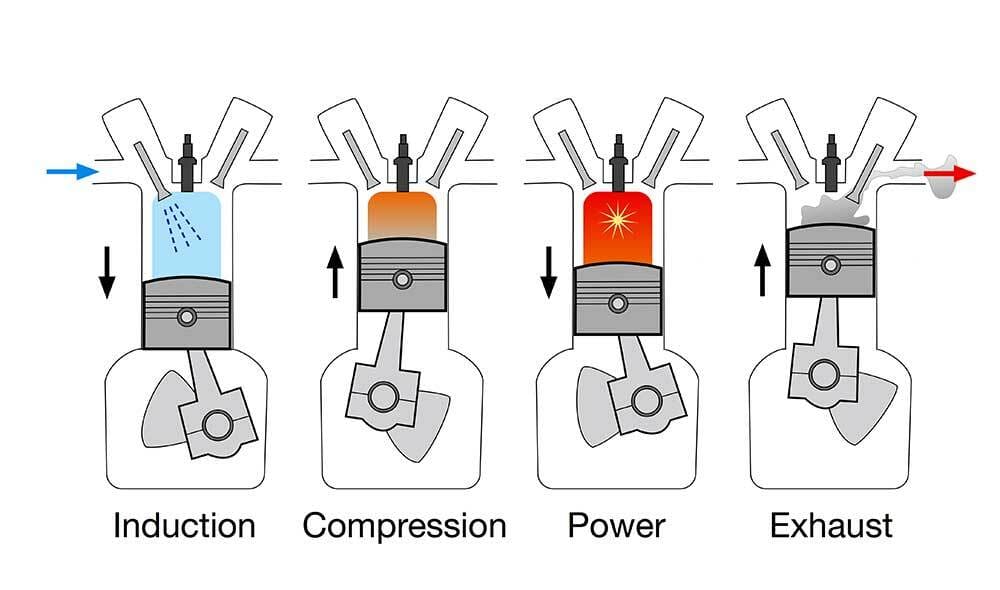
Engines are designed to transform one form of energy into another, usually chemical energy from fuel or batteries into mechanical energy (motion). The term “engine” is sometimes used interchangeably with “motor”, but the distinction is that motors operate on electrical energy while engines run on the combustion of fuels. Furthermore, there are various types, such as reaction engines, electrical engines, thermal engines, and more.
A type of thermal engine, the internal combustion engine is one of the most commonly used. It transforms chemical energy (in the form of fuel) into mechanical energy that can power most vehicles, including bigger machinery like airplanes and trains, and it can even be used to generate electrical power.
The way an internal combustion engine functions is quite simple. First, air is taken from the atmosphere and mixed with fuel. In a gasoline-powered engine (such as what you’d find in many cars), the piston squeezes the air-fuel blend, a spark plug delivers a spark to the mixture, and combustion occurs. The resulting explosion causes immediate pressurization in the combustion chamber, forcefully moving the piston which subsequently turns a crankshaft. The leftover gases and particles are then ejected from the chamber to be expelled via an exhaust system.
This process can happen up to several thousand times a minute and can be used for various purposes, such as driving the wheels of a car. And if you want to physically represent this process, a great way to do it is with a 3D printed engine! So let’s take a look at the most advanced 3D printed engines.
Printable Engines
Most of the following 3D printable engines have detailed printing as well as assembly instructions. From miniature model car engines to balloon-powered engines, there’s something for everyone!
Spring-Propelled
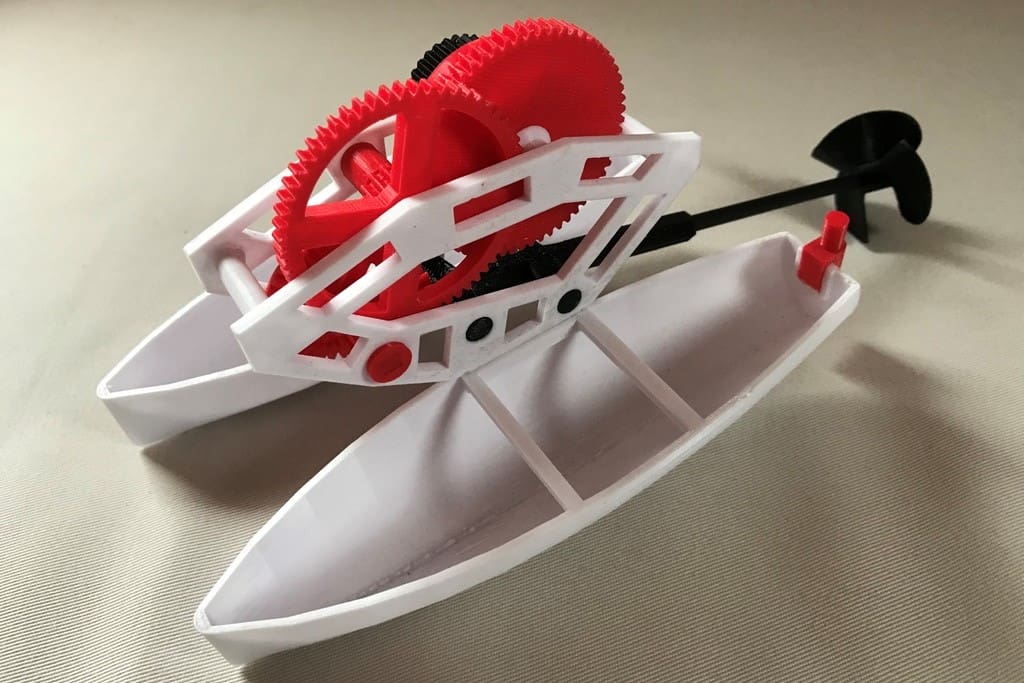
The spring-propelled catamaran is an update of a model that started as a paddle boat. Its creator upgraded the engine to a spring motor that works on the principle of stored potential energy and converts it into kinetic energy, propelling the boat forward. The spring acts as the stored energy source and is somewhat powerful, but the range is limited.
All the required files are available for free on Thingiverse, and it also includes concept images and assembly instructions. However, it requires a lot of sanding and some lubrication for the parts to fit and run smoothly.
- How difficult is it? Easy
- Who designed it? FULspeed
- How printable/popular is it? As of yet, only one person has posted a make and another has posted a remix. There are a few positive comments over 800 likes.
- Where to find it? Thingiverse
Balloon-Powered Radial

We’ve seen engines powered by steam and running on air pressure, but can an engine run on just the air pressure provided by a balloon? The answer to that question is this balloon-powered radial engine.
The main factor that needed to be tackled was to reduce the friction to such an extent that the engine could function on the minimal air pressure provided by a balloon. The creator demonstrates how this engine works in a YouTube video and has provided detailed printing and assembly instructions. The engine has minimal gears and can even power a lightweight toy car.
- How difficult is it? Easy
- Who designed it? Slava_Z
- How printable/popular is it? As of yet, there are six makes with one remix and several positive comments.
- Where to find it? Thingiverse
Turbocharged 4-Cylinder

This easy-to-print turbocharged 4-cylinder engine was built by Thingiverse user DeSteiner, and he modeled it from scratch with 3D printing in mind. This means that parts are easy to print, don’t require supports, and are easy to assemble and disassemble without the requirement of any glue or screws. Moreover, even the turbo can spin, but it needs proper airflow and high revolutions per minute.
Apart from the 3D files, DeSteiner also provided detailed print settings with post-processing tips. The engine runs with the help of a belt (made from flexible filament), but he also made a remix of the same engine that is driven by gears rather than a belt. You can also check out how it works on YouTube.
- How difficult is it? Easy
- Who designed it? DeSteiner
- How printable/popular is it? To date, there are four makes and four remixes, along with many positive comments.
- Where to find it? Thingiverse
Transparent Steam
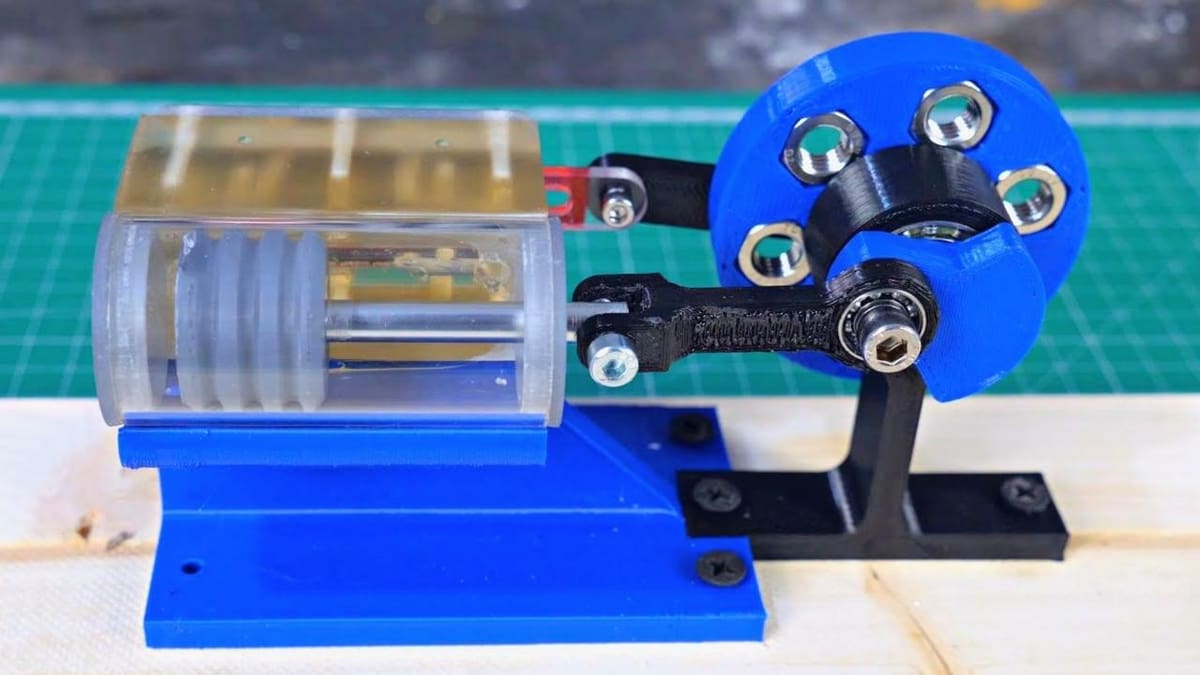
Joel from Integza is known for his interesting 3D printing projects, and one of them is a transparent steam engine that can be easily 3D printed. He also explains how a steam engine works, making it very easy for beginners to understand and make customizations if needed.
The entire transparent steam engine is modeled from scratch, works perfectly, and is available for download at Thangs. Furthermore, the download includes all the parts of the steam engine, and step-by-step instructions are also available in video format on YouTube.
Since the pressure from the source drops rather quickly, it doesn’t work for more than 15 seconds – but it’s still a fun project to build and to demonstrate the process behind steam engines.
Compressed Air

YouTuber Tom Stanton built a 3D printed compressed air engine and has made the files free to download. The crankcase, cylinder, piston, and other parts are printed in PLA, which means the results aren’t always perfectly smooth. So, the parts need post-processing in the form of sanding before being assembled for a smooth run. Apart from sandpaper, you’ll also require superglue and some lubricant to get everything moving.
Since it works on compressed air, you can either use a mechanical air pump or an electric air pump. Furthermore, like the transparent steam engine, this one can also run on steam if such a system is rigged. However, the creator warns to use safety equipment as the parts can fly off if not fitted well or if very high pressure is used.
- How difficult is it? Intermediate
- Who designed it? TomStanton
- How printable/popular is it? Currently, there are 6 makes of this design and 10 remixes, showing the community is involved in updating this project.
- Where to find it? Thingiverse, YouTube
Basic Car
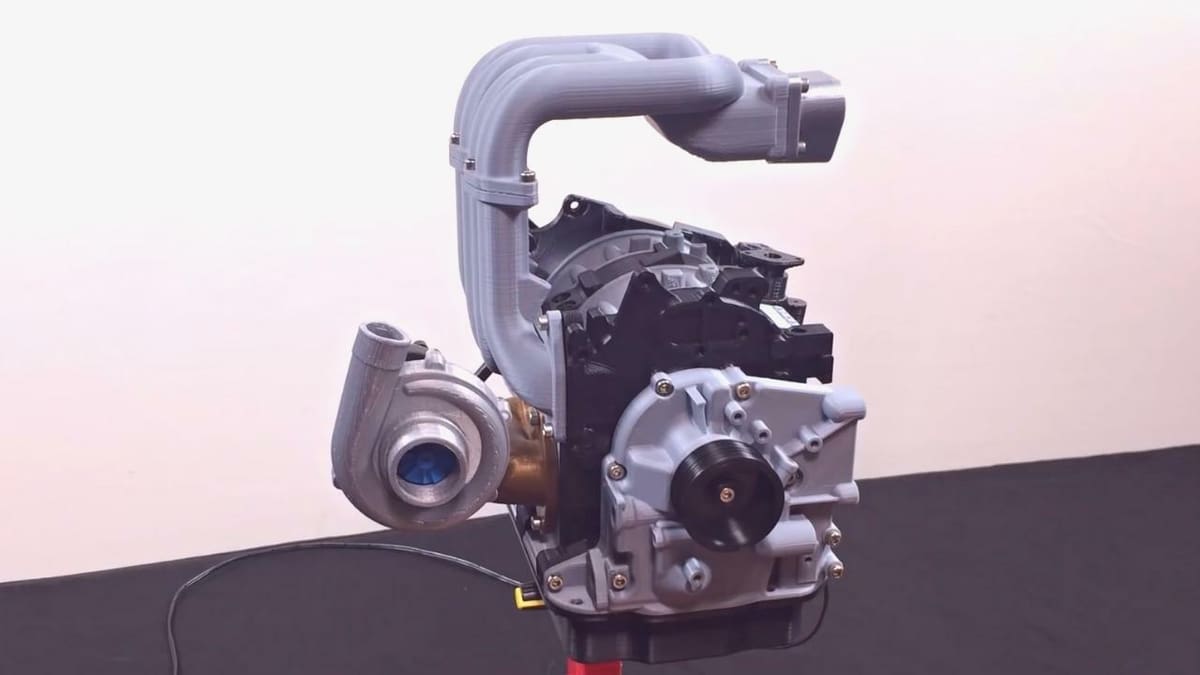
A typical car engine has around 200 parts, and it would be overwhelming to 3D print and assemble all of those. This is where Thingiverse user ericthepoolboy’s model engines come in: they use fewer parts to demonstrate how the main components work inside an engine. They do omit small and secondary parts but they also do a good job when you need to visualize a working engine.
The creator’s goal has always been to enable other people to reproduce his creations using their 3D printers at home. The Toyota and Mazda 3D printed engines are entry points to working engine models that are easy to print. While the Toyota model engine is referenced from an actual Toyota 22RE engine, the Mazda model engine is sculpted from internet references of a Mazda 13B-REW Wankel engine.
- How difficult is it? Intermediate
- Who designed it? ericthepoolboy
- How printable/popular is it? There are currently 98 makes of the Toyota engine and 20 makes of the Mazda engine with plenty of positive comments on both.
- Where to find it? Thingiverse – Toyota, Mazda
Solenoid V8
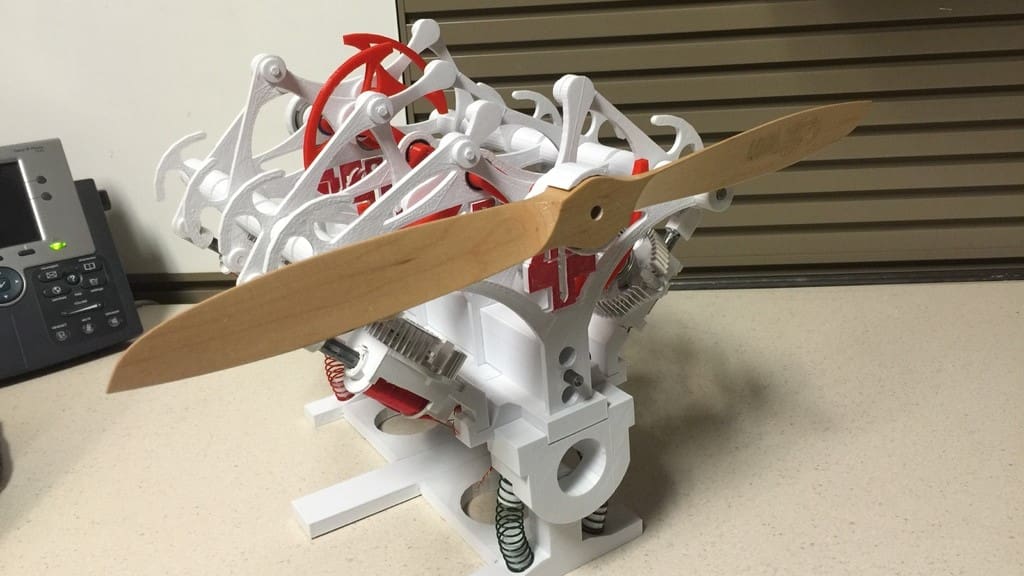
Powered by electricity instead of fuel, solenoid engines are exciting pieces of engineering to look at. Thanks to Thingiverse creator 7thCrook, the files for this model are available to download for free.
This same 3D printed solenoid engine is powered by a computer power supply and an Arduino. All the parts except wires, bearings, and fans were 3D printed. This project is a bit more expensive to build than others on our list because of the many non-3D printed parts needed, but go for it if you have the time and funds to do it!
- How difficult is it? Intermediate
- Who designed it? 7thCrook
- How printable/popular is it? No makes have been posted of this design yet but there are a few positive comments and almost 1,000 likes on it!
- Where to find it? Thingiverse
Traction
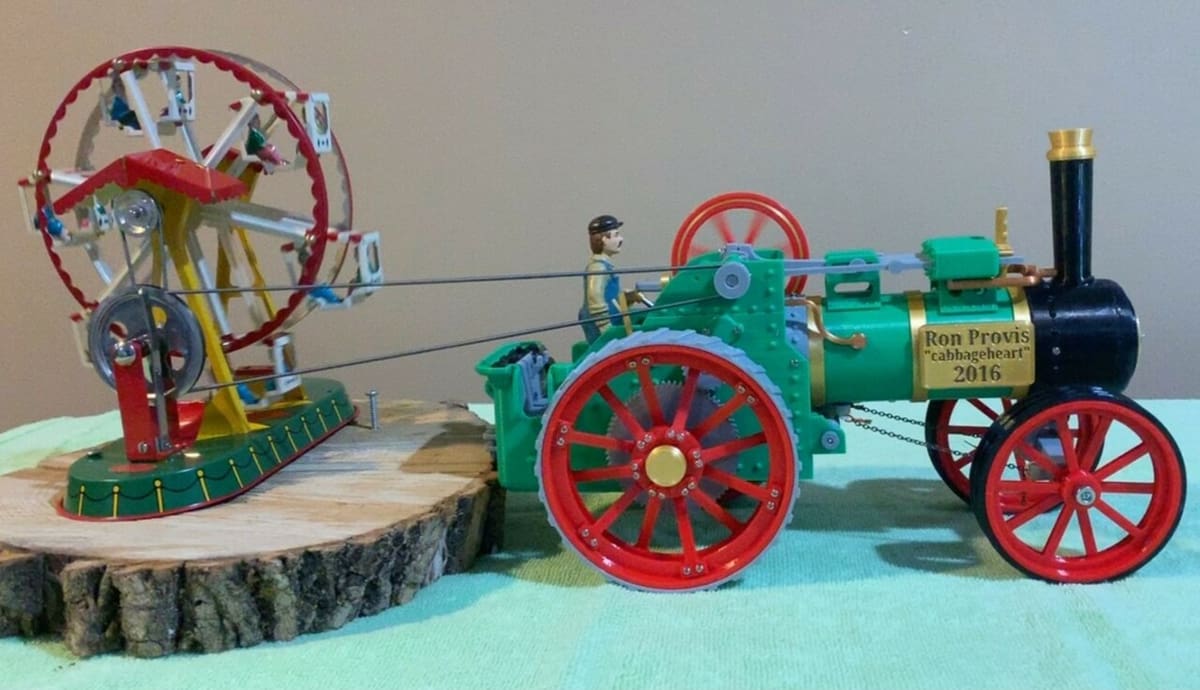
Want a traction engine that you can also control wirelessly? Thingiverse user cabbageheart had the same thought, so they decided to build a traction engine model with optional radio control. It was designed and built from scratch, but it needs some hardware for the remote control to work.
The creator provides detailed print settings as well as an assembly guide for reference. Although this particular model has over 80 parts that you need to print and also needs some additional tools, the outcome is worth it. You can see from the makes the dedication that people have put into recreating this and the fun range of accessories they’ve added!
- How difficult is it? Intermediate
- Who designed it? cabbageheart
- How printable/popular is it? For this model, there are 42 makes and almost 900 likes so far!
- Where to find it? Thingiverse
Complex Car
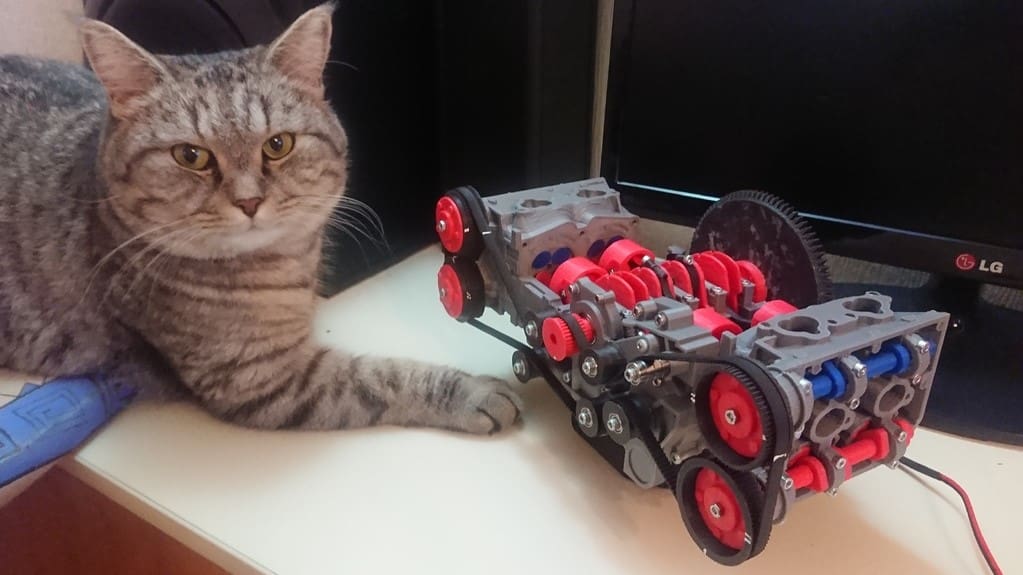
From the same designer of the Toyota and Mazda engines mentioned before, come two more advanced engine models. The Subaru model engine is a fully 3D printed Subaru WRX EJ20 boxer engine at 1/3 scale. Removing a few screws that hold the engine block’s top 3D printed part reveals the cylinders and valves, making it possible for you to see and learn about the layout of a boxer engine.
Or if a Chevy’s more your style, there’s also a 3D printed Camaro engine. This is a fully functional 3D printed replica of the Chevrolet Camaro LS3 V8 engine, which took 200 hours of 3D printing and 2 kg of PLA filament.
As with the simpler engines, these designs have the files, parts lists, and instructions included on the project pages so that anybody can recreate them.
- How difficult is it? Advanced
- Who designed it? ericthepoolboy
- How printable/popular is it? There are currently 21 makes of the Subaru Boxer and 45 makes of the Camaro V8 with many positive comments on both.
- Where to find it? Thingiverse – Subaru, Chevy
V6 Internal Combustion
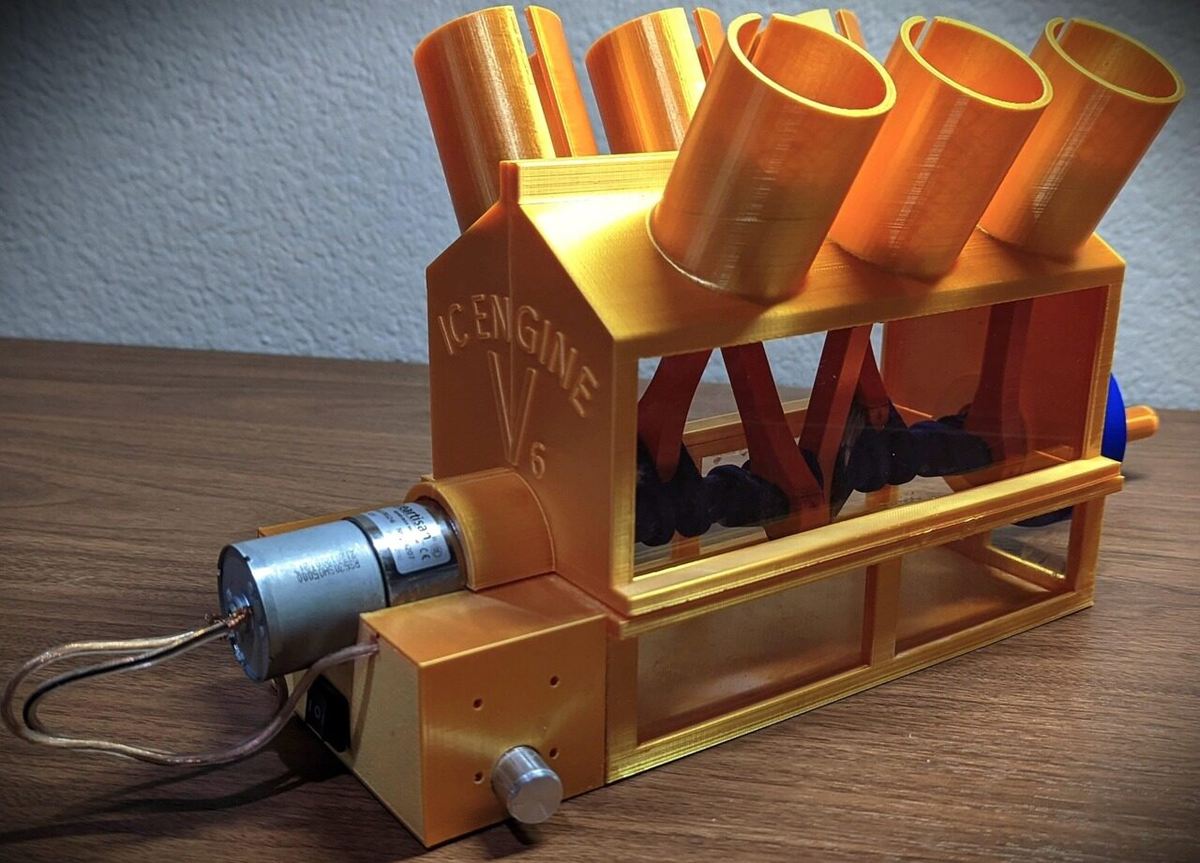
A few mechanical engineers from San Jose State University created this V6 engine that can be printed entirely with a desktop fused deposition modeling (FDM) printer. It has several viewports that allow one to easily view the key components and internal workings of a V6 engine by looking through them. The crankshaft is rotated by a DC motor, which moves the pistons up and down.
The majority of the parts used are 3D printed, with the exception of some hardware including bearings, acrylic sheets, DC motors, motor controllers, batteries, and electric wiring. According to the makers of this project, it takes approximately 72 hours to print all of the plastic pieces.
- How difficult is it? Advanced
- Who designed it? Aseesh Paul Bandaru and Vaishnavi Dabhade
- How printable/popular is it? This project currently has over 5,000 views with 59 likes plus a few positive comments.
- Where to find it? Instructables
Turbine
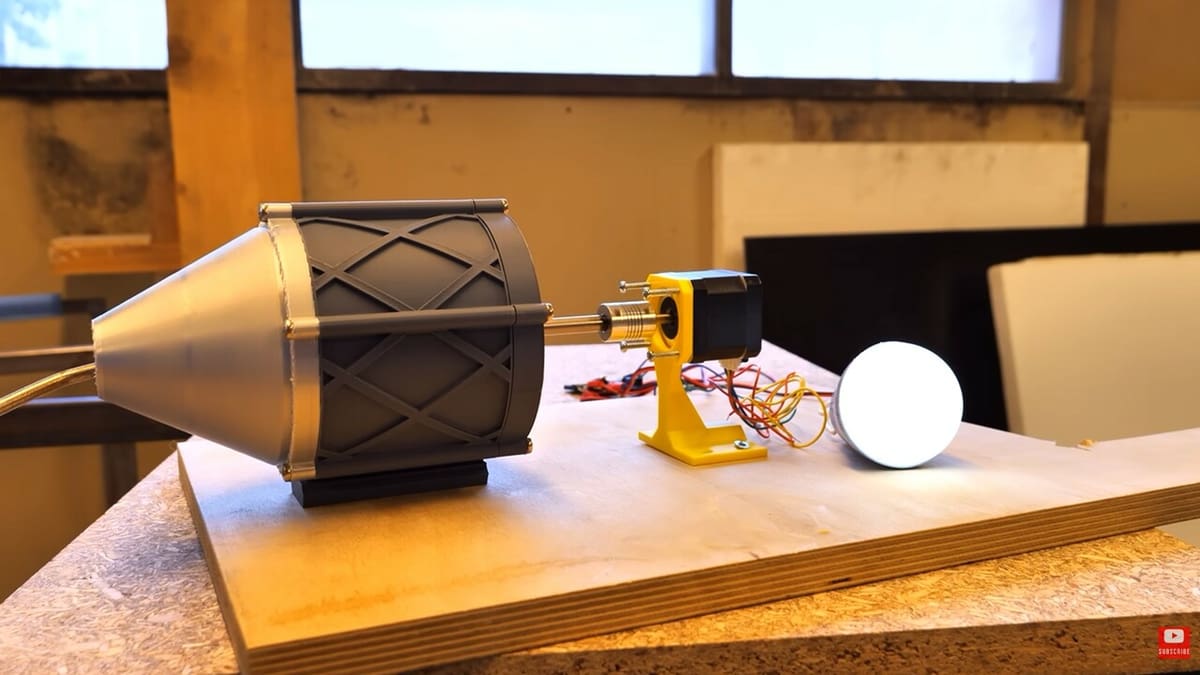
Next up, let’s check out a 3D printable impulse turbine engine. Although the word “turbine” may bring to mind the engines used in airliners, these engines have distinctly different mechanics. The turbines used in airliners are intended to generate thrust by combining air and fuel and combusting that mixture. On the other hand, the 3D printable turbine here imitates turbines that use compressed air as an external force to drive several rotors, causing a centrally mounted shaft to rotate while the entire turbine remains stationary. Several industrial power plants use this type of turbine with steam rather than compressed air.
The design for this turbine consists of several rotors, stators, and an external housing that are all 3D printable. The only non-3D printable parts are a few small screws and the central shaft. As this design uses plastic parts, it’s not advisable to use steam to power the turbine, as the plastic would obviously melt. The maker uses both compressed air and pressurized water as driving forces.
The turbine in its original size is bigger than a soda can but can still be printed in a relatively short time. The turbine in action can be seen in a YouTube video along with more information on the mechanics of this and other turbines.
- How difficult is it? Advanced
- Who designed it? LetsPrintYT
- How printable/popular is it? This project currently has almost 600,000 views on YouTube and more than 500 likes on Thingiverse. There are no makes posted yet.
- Where to find it? Thingiverse, YouTube
Innovative Projects
So far, we’ve seen projects that can be 3D printed and built with the help of instructions, and all of the above are available to download for free from their respective creators.
But now, let’s go ahead and check out some exciting and innovative projects! You can’t print them but can definitely enjoy how they work.
Combustion Engine

Have you ever thought about creating a combustion engine, but limiting yourself to mainly using plastic 3D printed parts? YouTuber Camden Bowen challenged himself with exactly this project and discovered that it is indeed possible.
After considering the engine design, Camden Bowen decided to use the classic 4-stroke system on a single-cylinder engine. He faced several obstacles, including having to create compression, fuel, and spark. Camden documents this design journey on YouTube, where he redesigned the engine multiple times. Eventually, he was able to get his plastic combustion engine to fire for a complete 2 seconds!
However, due to limitations such as low melting temperatures, rubbing-induced deterioration, and poor tolerance, he was unable to improve the engine any further using plastic parts. Therefore, he decided to use metal 3D printed parts to solve this problem. Assembling the engine with metal 3D printed parts, he was able to make the run time last 5 times longer (10 seconds).
This extensive trial and error made by Camden shows how difficult it is to successfully 3D print a working combustion engine. But more importantly, it gives us an idea of the current capabilities of household 3D printers and what can be done in the future with a little more work.
- Where to find it? YouTube
Variable Valve Air Powered
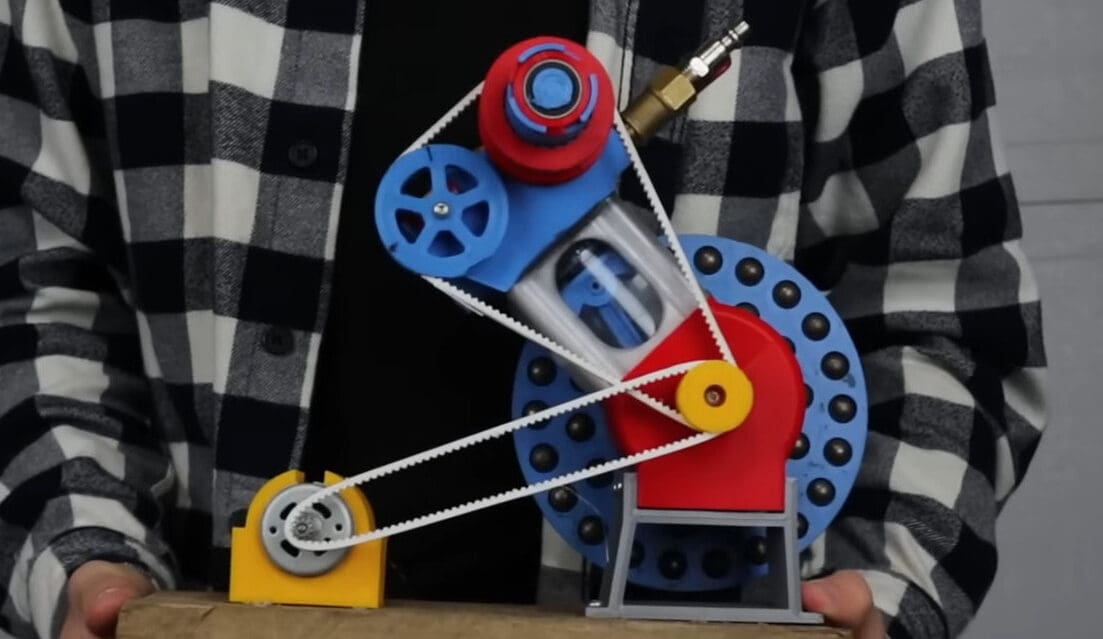
Camden Bowen has created numerous 3D printed engines in the past. While many of his designs are combustion engines, as showcased in the previous section, he has also developed a unique 3D printed air engine.
Air engines are machines that use compressed air as a source of power to generate mechanical motion. They work by expanding compressed air to drive pistons, converting the stored energy into useful work, such as powering vehicles or machinery. They’re often used in applications where combustion engines are impractical or where emissions need to be minimized.
Air engines, while conceptually simple and environmentally friendly due to lack of combustion emissions, often suffer from lower efficiency compared to combustion engines. This inefficiency primarily stems from the piston’s downward movement beginning before air can fully pressurize the cylinder. However, a remedy exists: timing the intake valve to open at or just before the piston completes its upward stroke. This adjustment grants air a prolonged window to pressurize, adding extra force to every downward movement of the piston. Nevertheless, this optimization introduces a caveat of lower engine speeds, increasing the risk of stalling.
Camden Bowen wanted to create an air engine that uses this remedy and decided on using variable valve timing or VVT. VVT optimizes the intake and exhaust valve timing to better match the engine’s operating conditions. By adjusting the timing of the valves, VVT technology can optimize airflow into and out of the engine, improving combustion efficiency and power output.
After some work and inspiration from Toyota’s 2JZ engines, Camden Bowen was able to achieve his goal by creating a button that changes the timing of his engine, resulting in an impressive-looking 3D printed engine with VVT. In this project, the YouTuber demonstrated once again what is possible with some knowledge and a desktop 3D printer.
- Where to find it? YouTube
Relativity Space Rocket Engine

We all know just how expensive, challenging, and complex rockets are. Relativity Space is a space start-up founded by Jordan Noone, who worked at SpaceX, and Tim Ellis, who gained experience at Blue Origin. The young firm’s goal is to massively reduce the cost of rocket launches and rocket build time thanks to metal 3D printing.
The founders think 3D printing “the whole thing” is what the future holds, and that’s why they’ve chosen 3D printing as their tool. Since there weren’t any metal 3D printers that suited the start-up’s needs, the founders decided to create the most advanced metal 3D printer to make their ambitious goal a reality.
Besides printing a massive fuel tank and various other parts, Relativity Space successfully 3D printed a rocket engine out of aluminum. The start-up shared a video demonstrating that their 3D printed engine, Aeon, has successfully completed its 100th hot fire test. As far as advanced 3D printed engines go, this for sure sits at the top!
- Where to find it? Relativity Space
NASA's RDRE
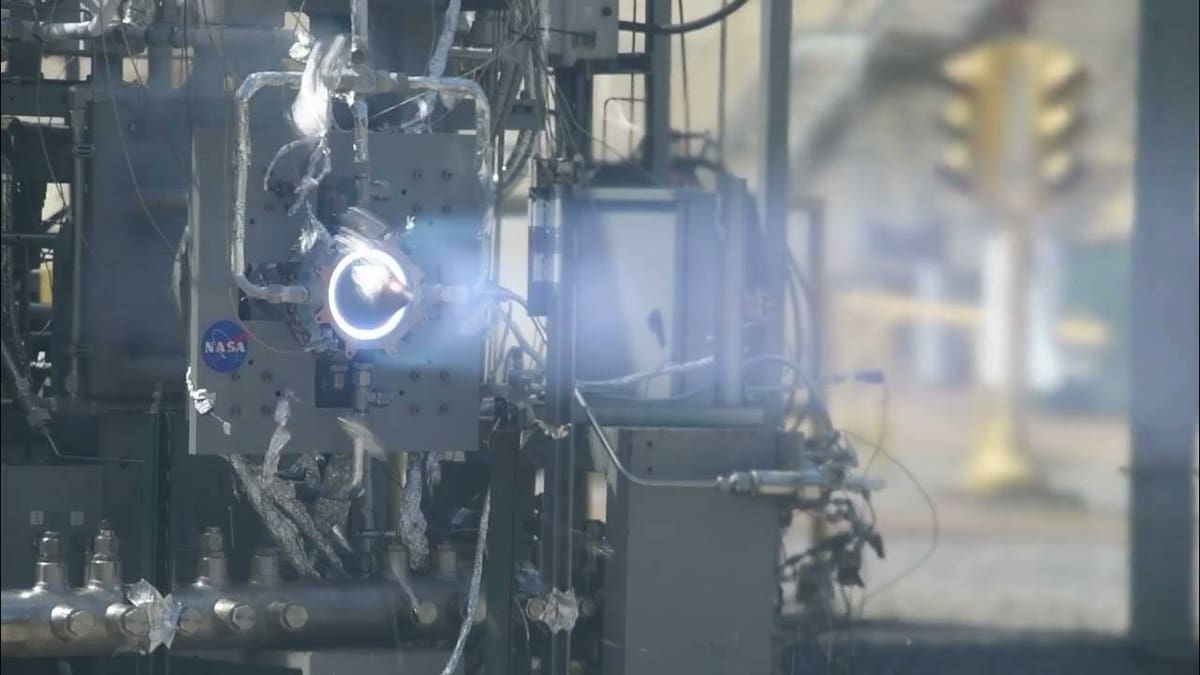
A rotating detonation rocket engine (RDRE) is an advanced propulsion system that uses a self-sustaining detonation wave rotating around a combustion chamber to generate efficient thrust for rocket propulsion. Compared to traditional rocket engines, RDREs offers potential benefits such as increased propulsion efficiency, reduced weight, and simplified design, leading to improved performance and cost-effectiveness in space exploration and satellite propulsion applications.
Recently, NASA successfully created and tested a 3D printed RDRE at the Marshall Space Flight Center. The engine produced over 5,800 pounds of thrust for more than four minutes. The NASA RDRE was made of copper-alloy GRCop-42 using powder bed fusion additive manufacturing. GRCop-42 is a high-strength alloy developed by NASA that contains niobium, chromium, and copper. It has an exceptionally high melting point and thermal conductivity, which means it can withstand the extreme conditions of a rocket engine and efficiently conducts energy away to avoid overheating.
- Where to find it? NASA
Rutherford Engine
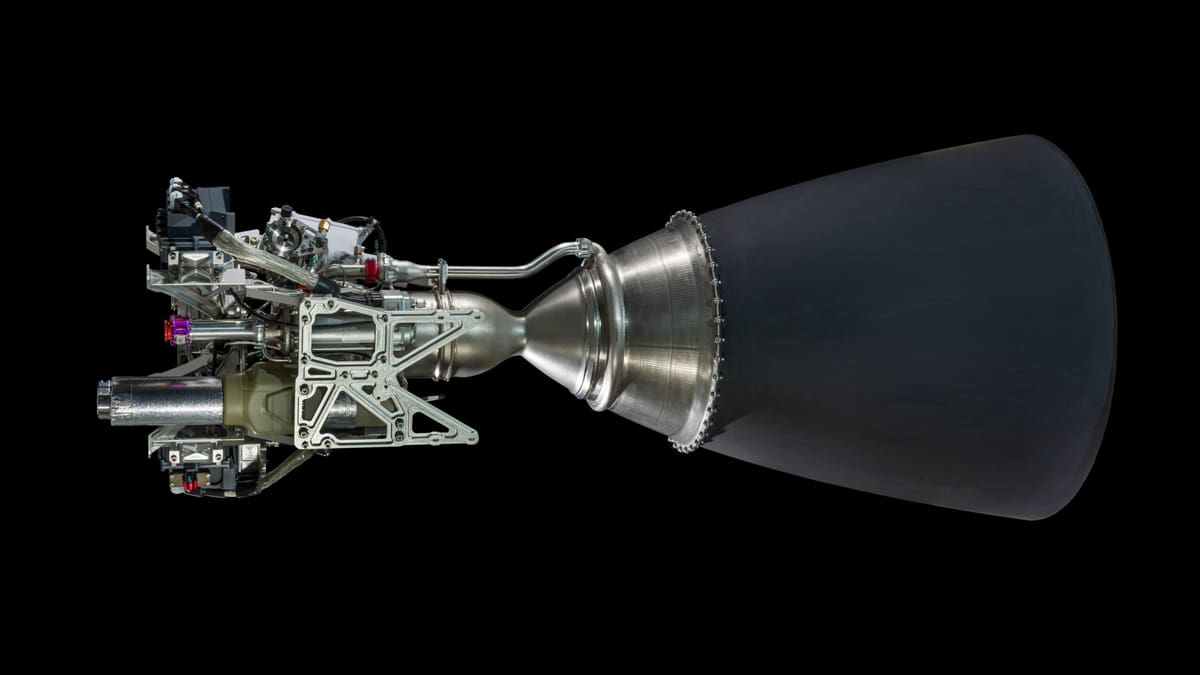
The Rutherford engine is an engine developed by Rocket Lab to power their Electron vehicles. The Electron is a small launch vehicle that accurately deploys satellites into orbit and sends its rockets parachuting back to Earth for mid-air retrieval or recovery after ocean splashdown. After retrieving the vehicle, it is refurbished and reused, unlike most aerospace machinery.
Nine sea-level Rutherford Engines power the Electron in the first stage of lift-off, and a single vacuum-optimized Rutherford engine powers the second stage. Rutherford engines are the first rockets to ever be 3D printed and electric pump-fed. Each engine utilizes brushless DC electric motors and lithium polymer batteries instead of gas turbine pumps, reducing complexity compared to traditional rocket engines while maintaining 90% efficiency.
The combustion chamber, injectors, pumps, and main propellant valves are all 3D printed using electron beam melting (EBM) technology. Amazingly, these primary components can be printed in 24 hours, and according to Rocket Lab, drastically reducing turnaround compared to traditional production methods.
350 of these rockets have been sent to space so far, proving to be a true benchmark of innovative success. With rockets like this that can be quickly manufactured and even reused, only time will tell how impactful these powerful machines will be on our understanding of what lies beyond.
- Where to find it? Rocket Lab
Hyperganic AI Rocket Engine

This AI rocket engine was forged by German software company Hyperganic. However, this engine isn’t a final product but a rocket engine prototype. The “AI” in the engine’s name represents the computer algorithms that designed it. Yes, you read that right! The engine design is the creation of artificial intelligence and it was 3D printed as one continuous piece.
The AI further learns from its previous designs, compares them, and keeps on improving its algorithms. This model includes a combustion chamber, and its surface has an inner lining that lets the fuel flow through, which acts as a coolant and prevents the engine from overheating. Although this engine is just a prototype, many aerospace organizations are interested in it, and it may evolve into something very crucial for the future of 3D printing.
- Where to find it? Hyperganic
License: The text of "The Most Advanced 3D Printed Engines" by All3DP is licensed under a Creative Commons Attribution 4.0 International License.
